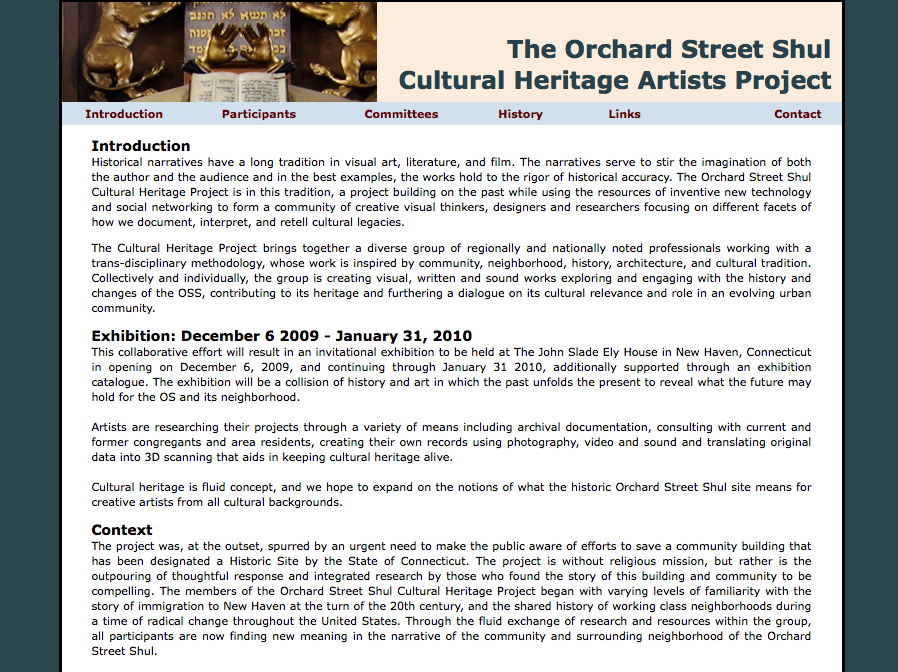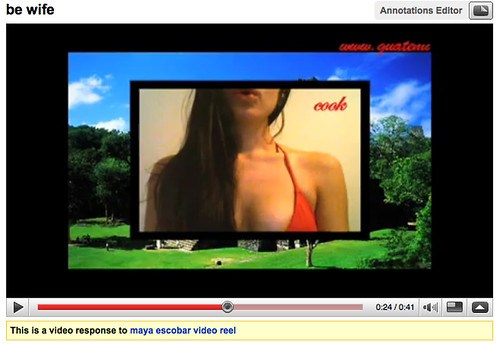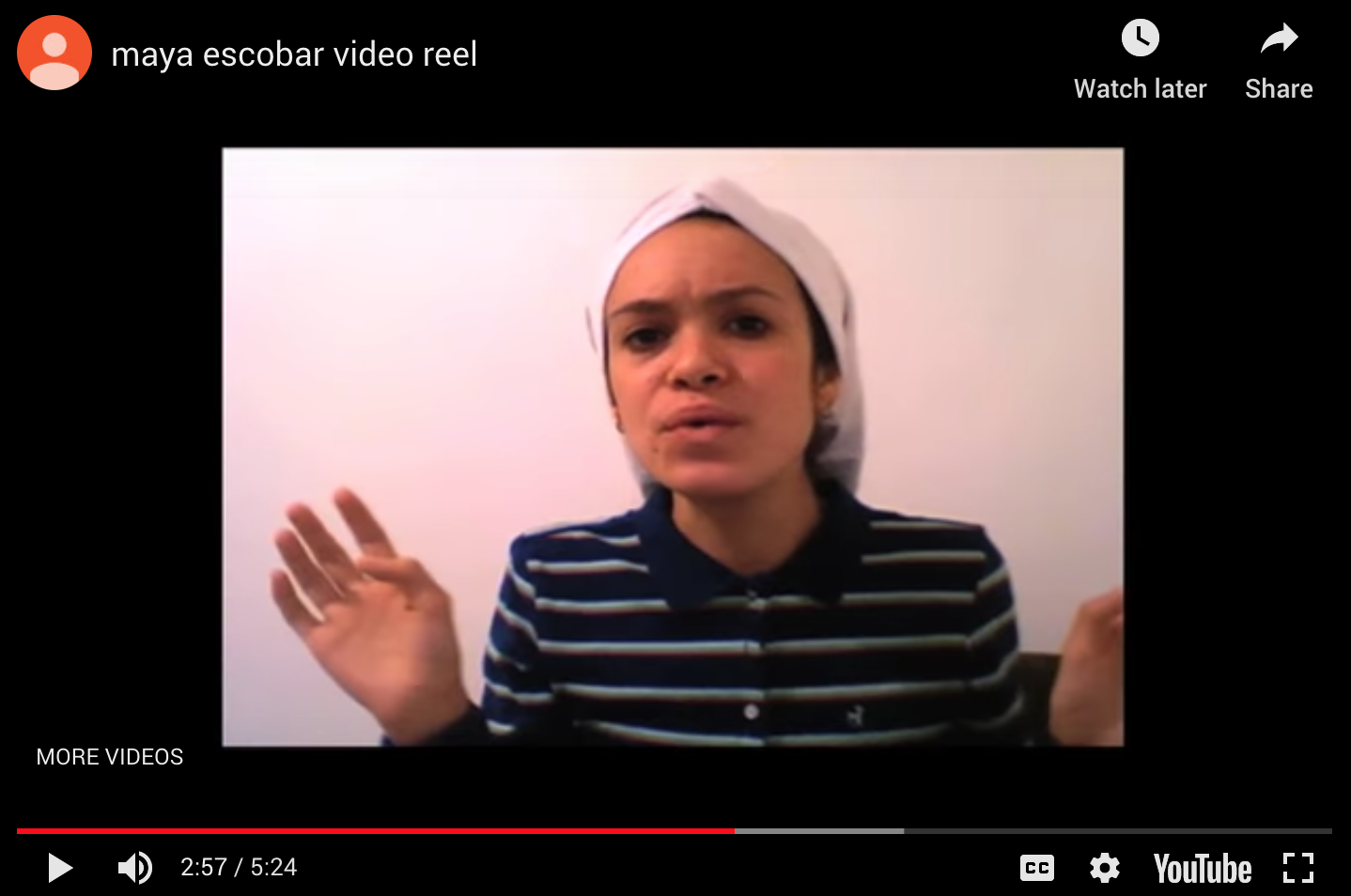Shomer Negiah Panties have finally arrived!! Get a them on ShomerNegiahPanties.com and Etsy Shomer Negiah is a concept in Jewish law halacha that prohibits any degree of physical contact with, or touching of, a member of the opposite sex, except for one’s spouse and immediate family. Shomer means “guards”, but due to its common use in phrases relating to religious practice, it has come to mean: “adhere to” as well. Negiah is the Hebrew word for “touch”, and thus Shomer Negiah is a term used to describe one who “guards the touch” or simply “adheres to restrictions of touch”. Although the feminine form of the term is technically Shomeret Negiah, it is almost always used in the masculine, even when in reference to women. Shomer Negiah Panties allow a woman to abide by the halacha, but still be individual and sexy at the same time.
Shomer Negiah is a concept in Jewish law halacha that prohibits any degree of physical contact with, or touching of, a member of the opposite sex, except for one’s spouse and immediate family. Shomer means “guards”, but due to its common use in phrases relating to religious practice, it has come to mean: “adhere to” as well. Negiah is the Hebrew word for “touch”, and thus Shomer Negiah is a term used to describe one who “guards the touch” or simply “adheres to restrictions of touch”. Although the feminine form of the term is technically Shomeret Negiah, it is almost always used in the masculine, even when in reference to women. Shomer Negiah Panties allow a woman to abide by the halacha, but still be individual and sexy at the same time.
Orchard Street Artist Cultural Heritage Project
My father and I participated in the Orchard Street Artist Cultural Heritage Project.
During the months of December 2009 and January 2010, The John Slade Ely House Center for Contemporary Art in New Haven, Connecticut will come alive with memories, recollections, and recreations of an important community heritage site, in an innovative group installation designed to both stimulate reflection on the legacies of past generations and engage the public in dreams for the future.The Orchard Street Shul Cultural Heritage Artists Project is an art exhibition, a history lesson, a point of cultural exchange, and meeting place for dreamers, both nostalgic and visionary. Artists, researchers, and scholars have joined together to celebrate an important historic New Haven landmark which was once central to the life of a large Jewish immigrant population in the Oak Street neighborhood.Urban changes in the last 50 years have all but erased evidence illustrating the importance of the Oak Street neighborhood in the lives of the newly arrived immigrants and migrants who populated much of the area now known as the "Oak Street Connector", Route 34. Where some see open space, or a new hospital, or a school, or a parking lot, others with longer memories see shops bustling with activity, voices shouting in Yiddish and Italian, sprinkled with a variety of accents from elsewhere, including near and distant regions within the USA.Contributions to the installation offer a range of approaches. Some artists researched the history of the Orchard Street Shul and its neighborhood, uncovering multiple stories of this community: stories of women working together to aid refugees, stories of hard-working fathers and mothers who dedicated themselves to making a better life for their children, and stories of teenagers who giggled and mingled on the steps of the Shul. Others built on their own experiences, reaching into their hearts to create depictions of the Shul that are evocative of deeper connections with history and community. Still others focused on the issues of urban renewal, making real the shifts in our urban landscape that are difficult to imagine as we visit the site today.Included in the Project are presentations by researchers from Yale University who developed innovative ways to document the building, including virtual reconstructions exploring new digital methods, ground-breaking research by computer scientists that promises to change the ways that cultural heritage sites will be documented in the future. Some contributing artists used this digital data in their creative work.The Orchard Street Shul Cultural Heritage Project is organized by Cynthia Beth Rubin, a New Haven based artist, in collaboration with participating artists and researchers: Nancy Austin, Meg Bloom, DonnaMaria Bruton, Jeanne Criscola, Roslyn Z. Croog, Linda Drazen, Paul Duda, Gonzalo Escobar, Maya Escobar, Alan Falk, Greg Garvey, Shalom Gorewitz, Jaime Kriksciun, Leslie J. Klein, Beth Krensky, Seth Lamberton, Mary Lesser, Lisa Link, David Ottenstein, Bruce Oren, Robert Rattner, Cynthia Beth Rubin, Holly Rushmeier, Janet Shafner, Frank Shifreen, Suzan Shutan, Sharon Siskin, Christina Spiesel, Yona Verwer, Julian Voloj, Laurie Wohl, Chen Xu, and Howard el-Yasin. The group includes artists from California, Florida, Utah, Missouri, Rhode Island, Massachusetts, and New York, who traveled to New Haven to contribute to the project alongside artists from the region.A Project Book is being published in conjunction with the exhibition, including essays by Haisia Diner, the eminent scholar of Jewish immigration history, Walter Cahn, renowned historian of art and and architecture, and Hana Iverson, known for her remarkable multi-media installation "View from the Balcony" that was instrumental in helping attract attention to the renovation project of the Eldridge Street Shul. The book will also feature photographs of the works in the exhibition and memories of the Orchard Street Shul, with commentary by Karen Schiff. The innovative book design is by Criscola Design.The Public is Invited to the Opening Reception for the Participating Artists, on Sunday, December 6, from 12:00 Noon to 5:00 pm. To set the mood for the launch of “The Orchard Street Shul Artists Cultural Heritage Project”, the Joseph Slifka Center for Jewish Life at Yale for Jewish Life at Yale will host a Jazz jam session on December 5 at 7:30, celebrating the swing dance music of 1924 and beyond, when the cornerstone of this Synagogue was put in place in a ceremony attended by Mayor Fitzgerald and much of the entire New Haven community.The John Slade Ely House Center for Contemporary Art is open W-F, 11:00 am to 4:00 pm, and weekends 2:00 pm to 5:00 pm. Schools and other organizations who would like to arrange a group visit outside of regular hours may do so by sending an email to: [email protected].
morning judge of character
take a picture of me for my myspace
In October of 2006 my rabbi started blogging. While trying to comment on one of his posts, I accidentally registered my own blog. Within hours of posting a comment, my name began appearing in Google searches. I was now linked to the post I had commented on, previous posts my rabbi had written, comments left by other users and the posts they had written elsewhere within the blogosphere. The rapidity with which I was branded, not only by my own online activity, but also by the online activity of others, seemed incomprehensible. I thought about this phenomenon in relationship to, the images that my friends and I had posted on Myspace throughout that year. I unknowingly went from being slightly annoyed and simultaneously amused by the phrase "take a picture of me for my Myspace", to it becoming completely natural and almost organic to document every moment, every outing, every time my friends and I put on make up, and to take pictures for Myspace. I saw this behavior even further exaggerated in the high school students I was student teaching. Their conversations were dominated with events that had transpired on Myspace, and when they were not talking about Myspace they were taking pictures for Myspace.When we talked about the factors that contributed to the construction of their individual and collective identities, my students were quick to bring up their style of dress, group of friends, the neighborhood they lived in, and the way they spoke. Yet not a single student referenced their online activity, the pictures they posted, the groups they joined, the comments they left on each others pages. I wondered why it was, that they were so aware of and adept at reflecting upon their experiences in the material offline world, but failed to mention the social network that played such a major role in their day-to-day lives.DECONSTRUCTING PERSONAL IDENTITY
I thought about this phenomenon in relationship to, the images that my friends and I had posted on Myspace throughout that year. I unknowingly went from being slightly annoyed and simultaneously amused by the phrase "take a picture of me for my Myspace", to it becoming completely natural and almost organic to document every moment, every outing, every time my friends and I put on make up, and to take pictures for Myspace. I saw this behavior even further exaggerated in the high school students I was student teaching. Their conversations were dominated with events that had transpired on Myspace, and when they were not talking about Myspace they were taking pictures for Myspace.When we talked about the factors that contributed to the construction of their individual and collective identities, my students were quick to bring up their style of dress, group of friends, the neighborhood they lived in, and the way they spoke. Yet not a single student referenced their online activity, the pictures they posted, the groups they joined, the comments they left on each others pages. I wondered why it was, that they were so aware of and adept at reflecting upon their experiences in the material offline world, but failed to mention the social network that played such a major role in their day-to-day lives.DECONSTRUCTING PERSONAL IDENTITY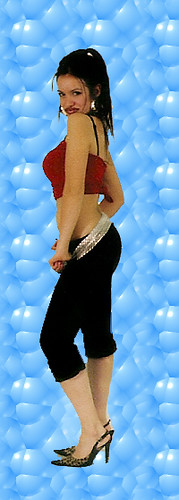 (today) I am referring to myself as a performance artist, Internet curator, and editor. I create and (concurrently) perform multiple online identities, by sampling from different representations of existing cultural discourses. I fragment my personal experiences and invite others to join in, and modify and regroup those fragments. By doing this I hope to share the process through which I deconstruct and reconstruct my individual conception of self, so that others can do the same in their lives.In the series Acciones Plásticas I performed representations of five constructed characters: a religious Jewish woman, a spoiled Jewish girl, a ghetto Latina, a sexy Latina professor, and a Mayan woman. I created low quality YouTube video blogs for four of the characters, the Mayan woman did not have a video, as she would not have had access to YouTube technologies. The videos were strategically placed on popular social networking sites, including YouTube and MySpace. The layout of YouTube contextualized the videos and framed them with user comments and similarly tagged user content. Jewish Girls was picked up by a popular left-wing Jewish blogging site Jewschool, and soon entered the Jewish Blogosphere where it was referred to as the JAP. This repositioning shifted the focus from the portrayal of multiple interwoven identities to a depiction of the Jewish American Princess. The JAP became how people knew my work, validating me while simultaneously conflating my identity with that of this particular character.
(today) I am referring to myself as a performance artist, Internet curator, and editor. I create and (concurrently) perform multiple online identities, by sampling from different representations of existing cultural discourses. I fragment my personal experiences and invite others to join in, and modify and regroup those fragments. By doing this I hope to share the process through which I deconstruct and reconstruct my individual conception of self, so that others can do the same in their lives.In the series Acciones Plásticas I performed representations of five constructed characters: a religious Jewish woman, a spoiled Jewish girl, a ghetto Latina, a sexy Latina professor, and a Mayan woman. I created low quality YouTube video blogs for four of the characters, the Mayan woman did not have a video, as she would not have had access to YouTube technologies. The videos were strategically placed on popular social networking sites, including YouTube and MySpace. The layout of YouTube contextualized the videos and framed them with user comments and similarly tagged user content. Jewish Girls was picked up by a popular left-wing Jewish blogging site Jewschool, and soon entered the Jewish Blogosphere where it was referred to as the JAP. This repositioning shifted the focus from the portrayal of multiple interwoven identities to a depiction of the Jewish American Princess. The JAP became how people knew my work, validating me while simultaneously conflating my identity with that of this particular character.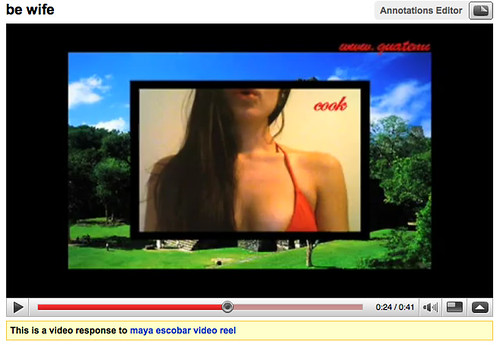 One of the strategies that I employed to counteract idea of "me as The JAP" was to group videos from the series Acciones Plásticas together with three other Youtube videos in a video reel of my work. The first video in the reel, el es frida kahlo is me dressed as Frida Kahlo where I violently scream I am Frida Kahlo! In second video Be Wife, I wear a bright red bikini top in front of an image of a Mayan temple in Tikal. Traditional Guatemalan marimba music plays in the background, while red text scrolls across the top reading Guatemala's finest export. The third video Que Sencilla, features me as a little girl, who is being coaxed by an off-camera male voice to perform a dance for the camera.Someone who is expecting to see a Jewish American Princess, is instead greeted with an enraged
One of the strategies that I employed to counteract idea of "me as The JAP" was to group videos from the series Acciones Plásticas together with three other Youtube videos in a video reel of my work. The first video in the reel, el es frida kahlo is me dressed as Frida Kahlo where I violently scream I am Frida Kahlo! In second video Be Wife, I wear a bright red bikini top in front of an image of a Mayan temple in Tikal. Traditional Guatemalan marimba music plays in the background, while red text scrolls across the top reading Guatemala's finest export. The third video Que Sencilla, features me as a little girl, who is being coaxed by an off-camera male voice to perform a dance for the camera.Someone who is expecting to see a Jewish American Princess, is instead greeted with an enraged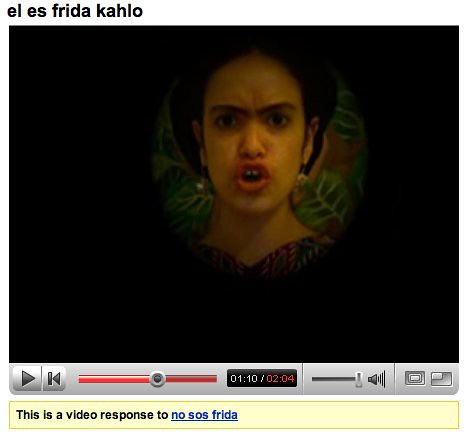 Latina artist, trying to fight the stigma of being associated with Frida Kahlo. My inclusion of these additional videos was to show the multidimensionality of the five characters initially presented in Acciones Plásticas. The Mayan women does not have her own YouTube video, but with the addition of the Be Wife video, her absence is felt even greater. The face of Guatemala in these videos, is the chest of a mail order bride. Another example can be seen within the four original videos themselves. With the grouping of the ghetto latina with the sexy latina professor, vast cultural and class difference can be seen between the two representations of Latina women. Put together with el es frida kahlo and Be Wife, there are suddenly five Latina performers all acting on one stage.
Latina artist, trying to fight the stigma of being associated with Frida Kahlo. My inclusion of these additional videos was to show the multidimensionality of the five characters initially presented in Acciones Plásticas. The Mayan women does not have her own YouTube video, but with the addition of the Be Wife video, her absence is felt even greater. The face of Guatemala in these videos, is the chest of a mail order bride. Another example can be seen within the four original videos themselves. With the grouping of the ghetto latina with the sexy latina professor, vast cultural and class difference can be seen between the two representations of Latina women. Put together with el es frida kahlo and Be Wife, there are suddenly five Latina performers all acting on one stage.
Jewish Girls Youtube Comments
Jewish Girls from the series Acciones Plásticas
[youtube=http://www.youtube.com/watch?v=GBjBN0ftcP0]Responses to Jewish Girls
[youtube=http://www.youtube.com/watch?v=PQphBV2Q0ZE]
Berlin's Eruv at the 2009 Conney Conference on Jewish Art
I will be presenting Berlin's Eruv at the 2009 Conney Conference: Performing Histories, Inscribing Jewishness at University of Wisconsin Madison. Berlin’s Eruv is a conceptual project that addresses the assumed non-presence of Jews in Germany. Berlin does not actually have an eruv. There is however, an active Jewish community, one that is frequently overshadowed by the city's prominent monuments and memorials commemorating Jewish life (death). Berlin's Eruv weaves together voices from Berlin's Jewish community in an attempt to construct a metaphorical eruv representative of a living Jewish Community. Just as the eruv exists in the minds of the people who abide by it, Berlin’s Eruv manifests itself through the conversations surrounding the idea of the piece.*****I will be showing Berlin's Eruv at 2009 MFA Thesis Exhibition, opening May 8th at the Kemper Art Museum.
Berlin’s Eruv is a conceptual project that addresses the assumed non-presence of Jews in Germany. Berlin does not actually have an eruv. There is however, an active Jewish community, one that is frequently overshadowed by the city's prominent monuments and memorials commemorating Jewish life (death). Berlin's Eruv weaves together voices from Berlin's Jewish community in an attempt to construct a metaphorical eruv representative of a living Jewish Community. Just as the eruv exists in the minds of the people who abide by it, Berlin’s Eruv manifests itself through the conversations surrounding the idea of the piece.*****I will be showing Berlin's Eruv at 2009 MFA Thesis Exhibition, opening May 8th at the Kemper Art Museum.
Frida Kahlo at the synagogue: Maya Escobar
Frida Kahlo at the synagogue: Maya Escobar and the young Jewish-American Creationby David Sperber in Ma'arav Israeli Arts and Culture Magazine.translation by Shlomit NehoraiARTICLE IN SPANISH & HEBREWMaya Escobar is no doubt one of the 'hottest' things developing in the Jewish-American art scene. Escobar defines herself "dyslexic internet artist". And in order to view her work you need not wander far.Her work is mostly created in familiar internet format, and is most often displayed on Youtube. Escobar, daughter to a Jewish mother and Guatemalan father, defines her art work as ongoing personal anthropological-sociological research into the narrative language that uses contemporary media.[youtube=http://www.youtube.com/watch?v=3li_mT--f-A]The "Acciones Plasticas" work includes short films that present a series of convincing characters and monologues that deal with identity questions. In the first short film in the series she appears dressed up as the Mexican artist Frida Kahlo who became an icon within the feminist discourse. it is commonly argued that Kahlo had some Jewish roots. Escobar is dressed and made up as is famously attributed to Kahlo - the uni brow - while screaming "I am Frida Kahlo, you are Frida Kahlo, we are Frida Kahlo". In agitation or in ecstasy she tears her custom, messes up her hair, wipes her make up off of her face and returns to being herself. In another short film in the series she carries on with a monologue of a jewish orthodox woman. The text here is so exact that for a minute the line between irony and slapstick to deep seriousness is blurred. In another short film the stereotypical Latin female as a sexual sensual object is presented, when here too the subject is moving between embracing the stereotypes and breaking them. Escobar is presenting different episodes that she had experienced herself and that deal with her hybrid identity as a woman, as a Jew and as a Latin American.[youtube=http://www.youtube.com/watch?v=NNAxEUEE43Y]
Another work of Escobar is "my shtreimel" - a video-blog that is also presented on Youtube.In that piece appears a young man in his twentieths who sits in his room in front of a computer and talk about his Shabbat rituals. The monologue describes an amorphous jewish world in which jewishness lives and materializes without obligation to its institutions and mostly in personal frameworks. A central part in this world is self deprecation: The young man shows his beloved shtreimel and mentions that the shtreimel which looks like the traditional is actually a women's hat purchased at a thrift store.
In the work "eruv" (intermingling) Escobar relates to the fact that in Berlin there is no eruv even though there exists a vibrant jewish community. In a series of photographed interviews with the city's citizens she transforms the notion eruv - from a halachic-legal notion that creates a conversion of the public space into the private space, into a blending - the creation of a multiple of characters and worlds. The blending (eruv)transforms into a cultural concept that celebrates the different and the unique. The individuals create a splendid mosaic that assembles anew the "collective" as a social concept. The way Escobar deals with the subject is typical to the jewish-american art world that tends to transfer concepts from the practical halachic and transfer them to another world, and so they transform into a metaphor of the personal or social condition. The personal experience is significant to Escobar: " Like other jewish rituals, the Shabbat encompasses practicalities that materialize private condition in a private space. Except that the understanding of the private space and the public space is fluid and changes at all times. I think that it is very important that people celebrate their Shabbat as a pleasant experience, defined and personal. The Shabbat rituals evolve all the time - not as an unbending obligation that is transferred from generation to generation, but as a result of a simple choice of the individual to create to him/herself nice and pleasant Shabbat customs. We all have these kind of customs."The intercontinental use of the Internet gave birth to a generation of individuals who create for creation's sake, and the concept of art for art's sake gets that way a new meaning. The Internet media connects individuals and contributes to mutual influences between people who work separately in far away places. The young work on the Internet challenges the old definitions in relation to what is considered art and what isn't. Similarly, it adopts new presentation forms that are not the norm in the art world's mainstream, and breathes new air into the art field.The discussion into Escobar's work leads into a wider discussion about the differences between the Jewish thinking in the Israeli discourse into the new understanding of the American world view. The Jewish-artistic engagement in the United States is influenced by the introduction of new-age ideas into the center of the conversation, and is integrating into the effort to create a connection between contemporary culture and the traditional Jewish identity. Within the American-Jewish community there are signs of a move from an organized institutional Jewish expression into a unique and personal expression of the very personal experience. These artists reorganizing the traditions on their own terms, and in this way contributing not insignificantly to the definition of Jewish-American Non-Orthodox Modern-orthodox anew. The link between Jewish culture and Jewish identity to art occupies a central role in this conversation.The echoes of this tendency can be seen in Israel as well ( in the young Yiddish culture developing in Tel Aviv, for instance ), but generally there is still a deep disconnect between the dominant concepts in Israel and in the United States. In Israel it is common to connect between Judaism to an organized tradition and to a blood line that is based on a genetic continuity. On the other hand, many young Jewish-Americans marry outside their religion, but nevertheless see themselves as an integral part of the Jewish world and expect to not be expelled from it. As opposed to Israelis who experience their Jewishness in terms of disintegration that followed restoration, the Jewish-Americans create new branches where growth and rebirth metaphors fit them better.The joining of contemporary culture and art to Jewish creativity expresses itself in fashionable characteristics like tattoos, hip-hop music, Internet art and the like, and is often understood as the disconnect with the accepted binary dichotomy between holly and the common. That is why conservative bodies see these art forms as a dangerous provocation. These new cultural concepts interconnect during confrontational discussions with the old cultural concepts. Philologically speaking it can be said that borrowing symbols from one discipline to another interferes with the semiotic systems. In the Kabalistic vernacular it is said that the energy that is released during the friction that is created by the disintegration of the usual vessels - creates "new light".
1000 Rabbis Call On Obama
[youtube=http://www.youtube.com/watch?v=KJ7Km7SEZ70] Time to Choose PeaceA Rabbinic Letter to President-Elect Barack ObamaRabbis, Cantors, and Jewish clerical students:Join your colleagues in urging President-elect Obama to make resolution of the Israeli-Palestinian conflict a top priority of the incoming administration by signing on to the statement below.Current List of SignersFrequently Asked Questions (FAQs)DONATE to support media campaign around the letterSigner DisclaimerNOT A RABBI OR CANTOR? CLICK HERE
Time to Choose PeaceA Rabbinic Letter to President-Elect Barack ObamaRabbis, Cantors, and Jewish clerical students:Join your colleagues in urging President-elect Obama to make resolution of the Israeli-Palestinian conflict a top priority of the incoming administration by signing on to the statement below.Current List of SignersFrequently Asked Questions (FAQs)DONATE to support media campaign around the letterSigner DisclaimerNOT A RABBI OR CANTOR? CLICK HERE
Text of the Letter
We the undersigned, call on you, President-elect Obama, to pledge to make resolution of the Israeli-Palestinian conflict a top priority of your Administration.While you come into office with a long list of problems before you, the long-simmering conflict between Israel and the Palestinians is among the most urgent. After eight years of half-hearted diplomacy, there is no time left to walk softly and hope for the best.The consequences of failing to establish a durable peace are grim. The influence of Iran and Hezbollah would grow among an increasingly bitter Palestinian population, and extremists would have further excuse to do vicious battle with the West. It is difficult to calculate the damage that a downward spiral into fresh waves of violence could hold.American Presidents traditionally look to the Jewish community for insight on Israel-related policy. As Jewish clergy, we pledge to mobilize our people behind your leadership for a mutually-acceptable, two-state solution. We pledge to support you through difficult, trying times, and to celebrate with you when the job is done. We pledge to let the American public know: An American President who dedicates himself to the establishment of a durable Israeli-Palestinian peace acts in the best interests of Israel and the United States.* We call on you to dedicate yourself to the establishment of a viable Palestinian state living in peace alongside Israel early in your first term.* We call on you to appoint, within your first 100 days in office, a high-level, highly-regarded envoy to the region, an individual who has the ear of both Israelis and Palestinians, the respect of the American people, and ready access to your Oval Office.* We call on you to establish mechanisms of enforcement and follow-through, so that decisions made and agreements signed will be respected and brought to fruition.
Negotiating Diaspora Identities Through New Media
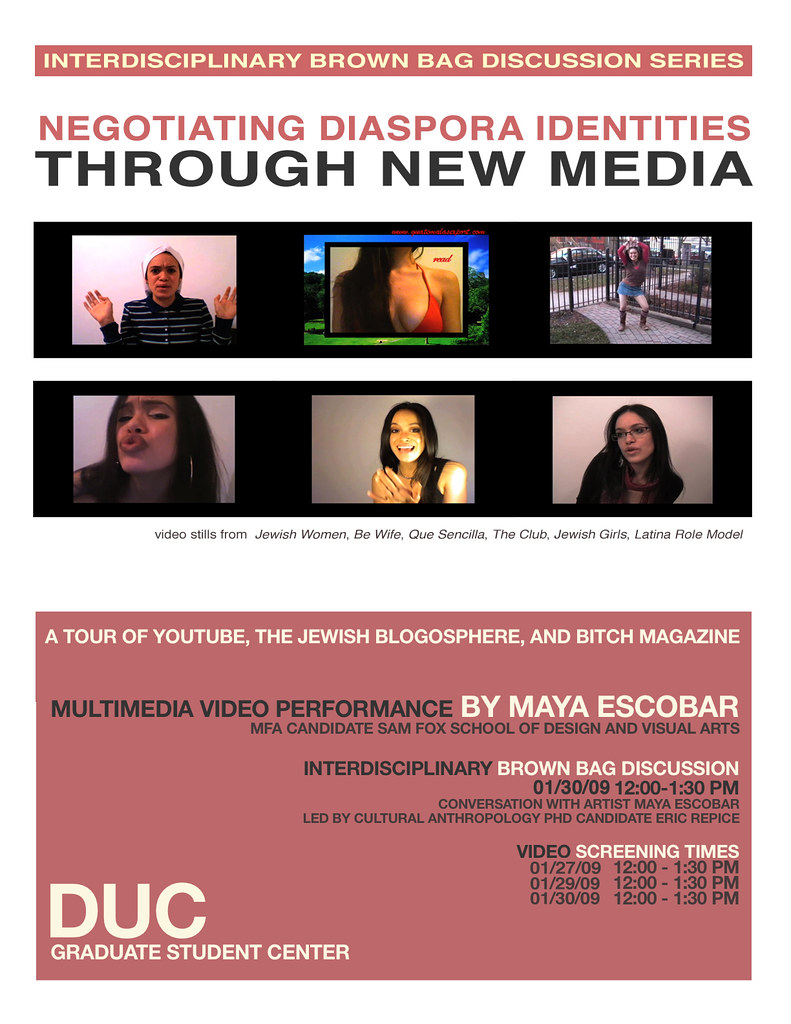 Join PhD Anthropology Candidate Eric Repice and MFA Candidate Maya Escobar in a brown bag lunch discussion concerning transnational, transcultural, and hybrid negotiations of identity through new media.How do these discussions vary between our fields?
Join PhD Anthropology Candidate Eric Repice and MFA Candidate Maya Escobar in a brown bag lunch discussion concerning transnational, transcultural, and hybrid negotiations of identity through new media.How do these discussions vary between our fields? Eric Repicefor more information on Eric Repice visit http://www.artsci.wustl.edu/~esrepice/homefor more information on Maya Escobar visit http://mayaescobar.com[youtube=http://www.youtube.com/watch?v=3li_mT--f-A][youtube=http://www.youtube.com/watch?v=G-GDmDcSH4g][youtube=http://www.youtube.com/watch?v=whLYM9o946w][youtube=http://www.youtube.com/watch?v=Vz2fhmRzCOA][youtube=http://www.youtube.com/watch?v=14bv0-dzMIc][youtube=http://www.youtube.com/watch?v=NNAxEUEE43Y]
Eric Repicefor more information on Eric Repice visit http://www.artsci.wustl.edu/~esrepice/homefor more information on Maya Escobar visit http://mayaescobar.com[youtube=http://www.youtube.com/watch?v=3li_mT--f-A][youtube=http://www.youtube.com/watch?v=G-GDmDcSH4g][youtube=http://www.youtube.com/watch?v=whLYM9o946w][youtube=http://www.youtube.com/watch?v=Vz2fhmRzCOA][youtube=http://www.youtube.com/watch?v=14bv0-dzMIc][youtube=http://www.youtube.com/watch?v=NNAxEUEE43Y]
Jewish Identity Questions- generated by the 2008 Jewish Multiracial Network Retreat Youth Staff with Artist Maya Escobar
I just returned from the residency I did for the Jewish Multiracial Network, located at Isabella Freedman Jewish Retreat Center. As part of my programming I worked with the youth staff to generate a series of questions regarding Jewish Identity. These questions then set the framework for the theater games (inspired by theater of the oppressed) and the flag books that we made over the course of the weekend.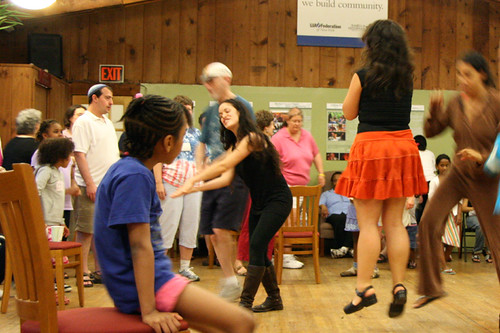 Unfortunately not everyone got around to answering these questions at the retreat, however here is a new chance :). So I now invite anyone and everyone to participate in finding answers to these questions (JMNners, non-JMNers, Jews, non-Jews..... )What do you need from society, yourself, the Jewish Community to recognize diversity and to become aware of racism, sexism, homophobia (oppression) both internalized and experienced and the times you yourself have been racist, sexist , homophobic, and then move past to create change?What do you do when you are in an uncomfortable situation regarding your Judaism?Do you have a Non-Jewish side, what is that like?What makes a person culturally Jewish?What make you a Jew in your everyday life?Define what makes someone Jewish.Name your greatest Jewish moment.Why are you Jewish?What does a Jew look like?Did you ever not feel Jewish?What is it about being Jewish that makes you most proud?What do you love about being Jewish?What was your weirdest Jewish Experience?Have you ever questioned your Jewish Identity?Has anyone else ever questioned your Jewish Identity?Have you ever questioned another persons Jewish Identity?What symbols represent Judaism for you?What non-Jewish activities do you partake in that to you are “Very Jewish”?What is your responsibility as a Jew of color?What is your responsibility as a Jew?
Unfortunately not everyone got around to answering these questions at the retreat, however here is a new chance :). So I now invite anyone and everyone to participate in finding answers to these questions (JMNners, non-JMNers, Jews, non-Jews..... )What do you need from society, yourself, the Jewish Community to recognize diversity and to become aware of racism, sexism, homophobia (oppression) both internalized and experienced and the times you yourself have been racist, sexist , homophobic, and then move past to create change?What do you do when you are in an uncomfortable situation regarding your Judaism?Do you have a Non-Jewish side, what is that like?What makes a person culturally Jewish?What make you a Jew in your everyday life?Define what makes someone Jewish.Name your greatest Jewish moment.Why are you Jewish?What does a Jew look like?Did you ever not feel Jewish?What is it about being Jewish that makes you most proud?What do you love about being Jewish?What was your weirdest Jewish Experience?Have you ever questioned your Jewish Identity?Has anyone else ever questioned your Jewish Identity?Have you ever questioned another persons Jewish Identity?What symbols represent Judaism for you?What non-Jewish activities do you partake in that to you are “Very Jewish”?What is your responsibility as a Jew of color?What is your responsibility as a Jew?
Joanna Angel: Jews & Tattoos
[youtube=http://www.youtube.com/watch?v=f9laK9l_lq0&hl=en]
- Adult film superstar Joanna Angel pokes holes at the myth that Jewish faith won't allow you to go to heaven if you have tattoos -- and Joanna's got quite a few -- during the Wild Ass Circus' trip to Las Vegas for the 2008 AVN Awards
Bitch Magazine
Acciones Plásticas was discussed in current issue of Bitch Magazine Lost and Found #38. The article is entitled The Princess Diaries: In an Age of Ostentation the J.A.P. is Back written by Julia Appel, a rabbinical student at Hebrew College.To view the full article (pdf version) click here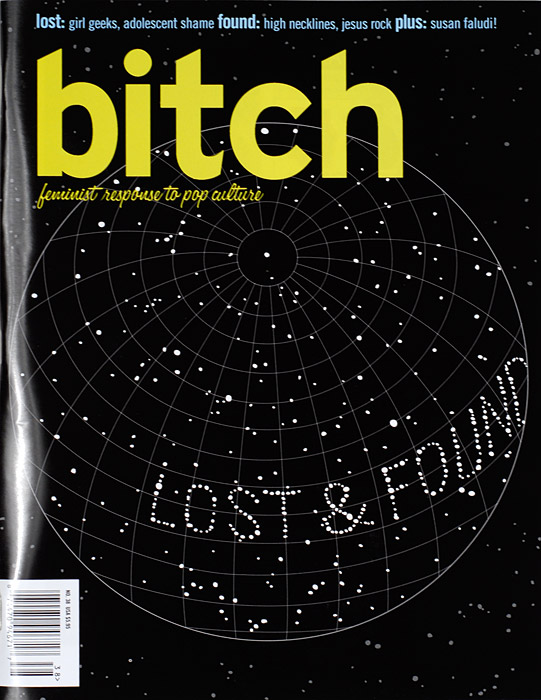
One blogger on Jewschool questioned the artistic success of a new piece by a performance artist named Maya Escobar entitled Acciones Plasticas (Plastic Dolls), in which the artist impersonates in short video segments various stereotypes that make up her identity. Her send-up of the J.A.P. was familiar to me from my years spent in a heavily Jewish, upper-middle-class suburb of Boston. Escobar's J.A.P. flips her straight dark hair and fiddles with her silver jewelry as she talks insipidly about her high-school popularity and rejection of male suitors. The blogger wrote by way of illustration, "She...nails the J.A.P. with a monologue so infuriatingly vapid and unaware it's as excruciating as the real-life experience."

[...]Using the Jewish American Princess in a deadpan manner can result in a sophisticated social critique that reveals how ridiculous the stereotype itself. The key is absurdity: Take Sarah Silverman, who frequently conjures the J.A.P. in her comedy, with mixed results [...] Maya Escobar's piece also falls in this category: by contextualizing the character in her video as a "doll" she reveals how ridiculous it is to take the character seriously. But what about the less-successful attempts at deploying the term? The reason "J.A. P." is ripe for reclamation is because it stands at the border between resonantly hateful and outdated. Although not as widely used as it once was, it still packs a punch. Therefore, if the context is not skillfully executed, the attempt serves not to interrogate or reclaim, but rather only to perpetuate the myth[...]
Shomer Negiah Panties
SHOMER NEGIAH PANTIES NOW AVAILABLE ON ShomerNegiahPanties.comShomer Negiah is a concept in Jewish law halacha that prohibits any degree of physical contact with, or touching of, a member of the opposite sex, except for one's spouse and immediate family. Shomer means “guards”, but due to its common use in phrases relating to religious practice, it has come to mean: “adhere to” as well. Negiah is the Hebrew word for “touch”, and thus Shomer Negiah is a term used to describe one who “guards the touch” or simply “adheres to restrictions of touch”. Although the feminine form of the term is technically Shomeret Negiah, it is almost always used in the masculine, even when in reference to women. Shomer Negiah Panties allow a woman to abide by the halacha, but still be individual and sexy at the same time. post by dovbear on the panties recieved these comments
post by dovbear on the panties recieved these comments
my pink sexy low cut bras say vlo sasuru in micro print ... lolfrumbabe | Homepage | 02.22.07 - 2:00 pm
why don't you ASK her, DB? Or would that be un-tznius (as opposed to, say, visiting her blog, looking at her panties, and then tattling on your own blog...) :)Tzipporah | Homepage | 02.22.07 - 2:34 pm
this is much more tzanuah.Trust me. I'm a man :)DovBear | 02.22.07 - 2:44 pm
"Shomer Negiah Panties," essentially ordinary cotton undies, I'm going to run over to CafePress and put some "Shomer Negiah Thongs" up for sale.Al Gore | 02.22.07 - 3:07 pm |
What about the fringes? Women unite for equality! We want fringes on our panties!Anonymous | 02.22.07 - 3:13 pm
How about upgrading to a tattoo strategically placed on one's behind? This could be a real trend on the upper west side!Anna Nicole | 02.22.07 - 3:18 pm |
How about upgrading to a tattoo strategically placed on one's behind? This could be a real trend on the upper west side!
Totally unecc. In Willy. they've found the combination of bald heads and really thick stockings serve the same purpose.DovBear | 02.22.07 - 3:27 pm |
that's a weird fetish. :)Tzipporah | Homepage | 02.22.07 - 3:31 pm |
Not a fetish. A form of birth control.Anon | 02.22.07 - 3:39 pm |
I think it's just for giggles. I could imagine SN girls giving each other these panties as a joke... the number of SN guys who'll ever see them on a girl is probably tiny.quietann | 02.22.07 - 4:10 pm |
Granny panties are by definition shomer negiah.--------
Perhaps what the world REALLY needs are burqas with playboy bunnies or 'party-babe' stencilled across the front.The Back of the Hill | Homepage | 02.22.07 - 4:18 pm |
DB:Been done before. Look, don't you think this makes the statement just a bit more...... pointed? http://www.corkscrew-balloon.com...torture/ 31.html
Anon:"A form of birth control"
A form of birth control??? Wow, I'd hate to know what you consider birth-out-of-control, then.Baal Devarim | Homepage | 02.22.07 - 4:33 pm |
that's hot....ThePervert | Homepage | 02.22.07 - 4:52 pm |
I just don't see it.Then why bother giving old Maya and her incredibly unfunny, juvenile and tasteless underwear any more free publicity? What motivates you to post what you do really mystifies.Chaim G. | 02.22.07 - 5:13 pm |
Oooh, these could be useful for the frum girl who secretly moonlights as a stripper. Warning, guys -- all lookie, no touchie.GoldaLeah | 02.22.07 - 5:19 pm |
the frum girl who secretly moonlights as a stripper. A match truly made in hell as her audience would no doubt comprise frum boys who secretly "moonlight" as patrons of "gentlemens" clubsChaim G. | 02.22.07 - 5:28 pm |
Kinda like the "Sanitized for your protection" ribbons on motel toilets.Psycho Toddler | Homepage | 02.22.07 - 5:54 pm |
A match truly made in hell as her audience would no doubt comprise frum boys who secretly "moonlight" as patrons of "gentlemens" clubs...I now have this mental image of bearded young gentlemen wearing ill-fitting 'gentile' clothes yelling "remove your sheitel, remove your sheitel". Thank you. It will take me a while to get over this trauma.The Back of the Hill | Homepage | 02.22.07 - 6:14 pm |
BOTHDain ershtoinung iz gornit antkegen der ershtoinung fun zaira vaiber If only such occurences were as humurous and harmless as the "sleeveless bar" scene that you conjured.Chaim G. | 02.22.07 - 6:20 pm |
I can see them being a present for a friend too--or a joke for one's husband.I don't see them having any halachic purpose, though. Unless there's a mitzvah to wear tacky panties that I somehow missed.balabusta in blue jeans | Homepage | 02.22.07 - 6:27 pm |
I'm married, and I would wear them. I think they're hilarious. But I'd be too scared to give them to anyone I know--they might take it the wrong way.Rivka | 02.22.07 - 8:39 pm |
Pardon me for the overshare, but I have a pair of panties that say "Girls know best" on the front. And there are times that they are appropriate for the situation, like maybe when I need a reminder that girls really do know best :) (I am almost 43, so hardly a girl, but the sentiment is the same.)Similarly, I could see a shomer negiah young woman wearing these panties on a date. Just knowing what her panties say might help her keep her skirt on!quietann | 02.22.07 - 10:21 pm |
at the mall any day now, i'm expecting to see "Shomer Negiah" stenciled on the butt of some babes yoga pants...eliyahu | Homepage | 02.22.07 - 11:15 pm |
I am truly mystified that this post existsreality | 02.23.07 - 7:38 am |
It's obviously a gag. What's the big deal? Girls that are really shomer are never going to wear them with any expectation that a guy will see them, and those that aren't will wear them for their ironic humor.nicejewishguy | Homepage | 02.23.07 - 11:15 am |
How about upgrading to a tattoo strategically placed on one's behind?Also know as a "Tramp Stamp."Al Gore | 02.23.07 - 12:26 pm |
It should also say "shomer negiah" in braille in case it's dark in the room when being read.Should also say it in Hebrew or Yiddish, so the message is clear to all chareidim as well.B.T.A. | Homepage | 02.25.07 - 1:54 pm |
Ah, should have looked at her site first. DB, now you're linking to tushies?! What a shonda. I go away for a few weeks...In any event, perhaps she could tatoo it on the small of her back, then could wear any panties she likes? Just a thought.B.T.A. | Homepage | 02.25.07 - 1:55 pm |
